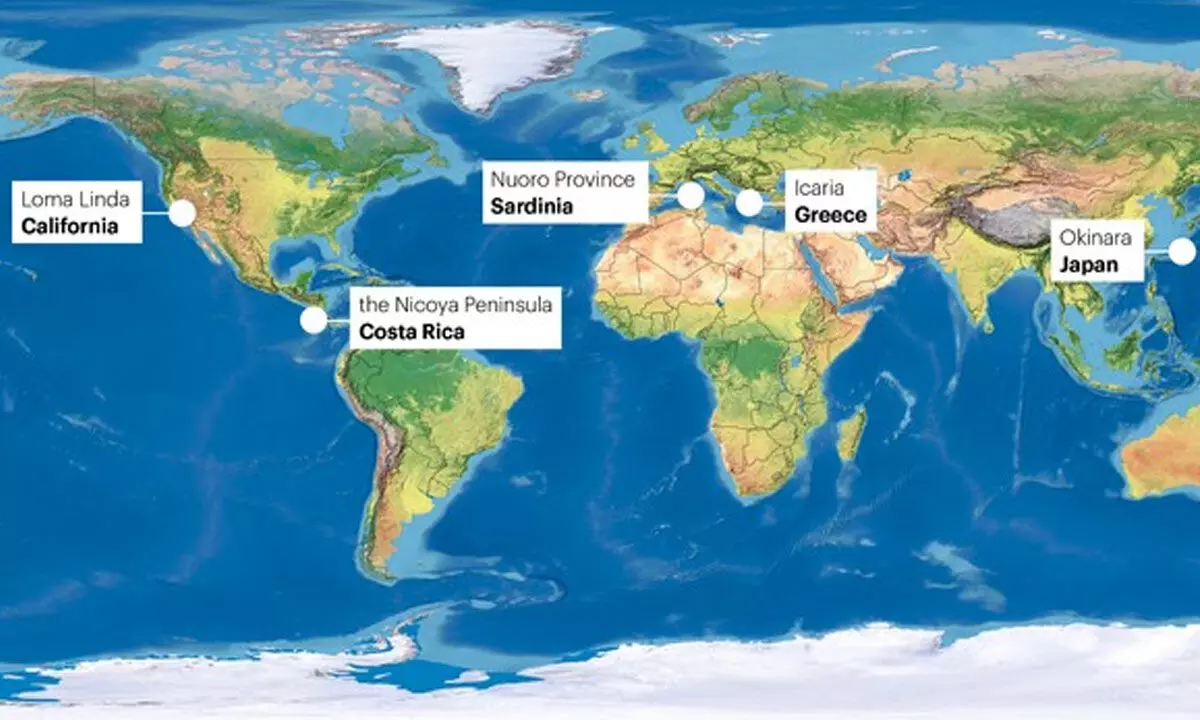Live
- Paddy procurement made easy in AP
- Aim to design Tirumala as a planned model town: TTD EO
- Partymen, aam aadmi air grievances before Dy CM
- NTPC Green to set up projects worth 1.87 lakh cr in AP
- CS holds review meet on ‘Indira Mahila Shakti’ scheme
- KTR to participate in Deeksha Diwas on Nov 29
- First Telugu bureaucrat to become CAG of India
- Plea in HC to extend voting rights to teachers in Council polls; notices issued to govt
- Political heat rises over Adani indictment in AP
- Excise police arrest five, seize 1.1 kg ganja
Just In
It’s time India targets to have Blue Zones


Blue Zones are regions of the world where people live longer, healthier, and happier lives.
Blue Zones are regions of the world where people live longer, healthier, and happier lives. The concept was developed by National Geographic Fellow and author Dan Buettner. There are five Blue Zones in the world: Okinawa (Japan), Sardinia (Italy), Nicoya (Costa Rica), Icaria (Greece), and Loma Linda (California, USA).
India has a life expectancy of 70.8 years, which is lower than the global average of 73.4 years 1. In 2021, the global average life expectancy was just over 70 years. This is an astonishing fact – because just two hundred years ago, it was less than half.
TheBlue Zone diet, which is based on the eating habits of people in the Blue Zones, can help Indians live longer and healthier lives. The Blue Zone diet emphasises whole grains, vegetables, fruits, nuts, and legumes, and discourages processed foods, sugar, and meat.
Incorporating the Blue Zone diet into Indian cuisine can be challenging, but it is not impossible. For example, replacing white rice with brown rice, using whole wheat flour instead of refined flour, and consuming more fruits and vegetables can be a good start. In addition to dietary changes, other factors that contribute to longevity in the Blue Zones include physical activity, social engagement, and a sense of purpose. In India, yoga and meditation are popular forms of physical activity that can help improve mental and physical health.
Incorporating the Blue Zone lifestyle into the Indian culture can be challenging, but it is not impossible. For example, people can try to eat more whole grains, vegetables, fruits, nuts, and legumes, and less processed foods, sugar, and meat. They can also try to engage in physical activity, such as yoga and meditation, and create a sense of community and belonging by spending time with family and friends.
India can become a Blue Zone by adopting the Blue Zone lifestyle, which emphasizes healthy eating, physical activity, social engagement, and a sense of purpose. Encourage people to consume more whole grains, vegetables, fruits, nuts, and legumes, and less processed foods, sugar, and meat. This can be achieved by providing education on healthy eating habits, promoting healthy food options, and making healthy food more affordable and accessible.
Encourage people to engage in physical activity, such as yoga, meditation, walking, and cycling. This can be achieved by providing access to safe and affordable public spaces for physical activity, promoting physical activity through media campaigns, and providing incentives for physical activity.
Next, foster social engagement. Encourage people to engage in social activities such as spending time with family and friends, volunteering, and participating in community events. This can be achieved by creating opportunities for social engagement, promoting social engagement through media campaigns, and providing incentives for social engagement.
Create a sense of purpose. Encourage people to find a sense of purpose in life, such as through work, hobbies, or volunteering. This can be achieved by providing education on the importance of having a sense of purpose, promoting opportunities for finding a sense of purpose, and providing incentives for finding a sense of purpose. By adopting the Blue Zone lifestyle, India can improve the overall well-being and life expectancy of its citizens. It is important to note that this is not an easy task and requires a concerted effort from individuals, communities, and governments. These remarkable shifts in one’s diet and activities, along with advances in medicine, better public health, and living standards can lead to longer life expectancy. Governments, Central and State, while striving for economic growth need to focus on poverty reduction, thereby food security, and improvements in public health.

© 2024 Hyderabad Media House Limited/The Hans India. All rights reserved. Powered by hocalwire.com






